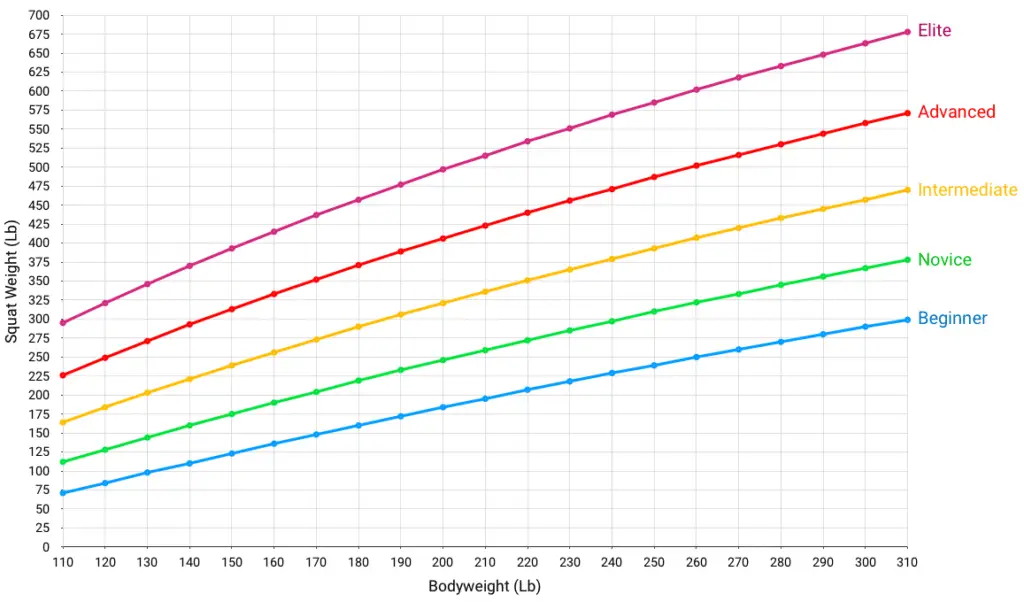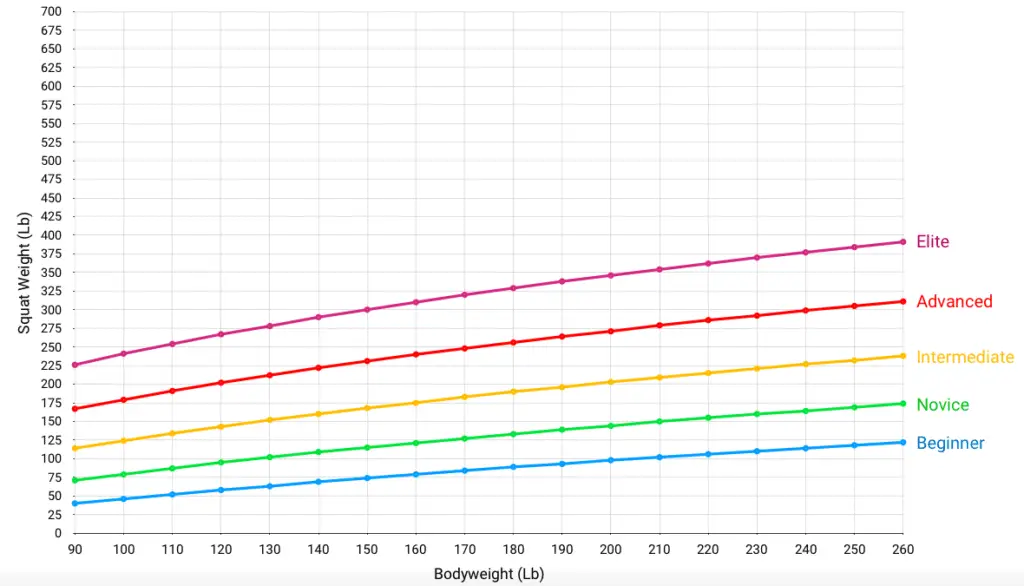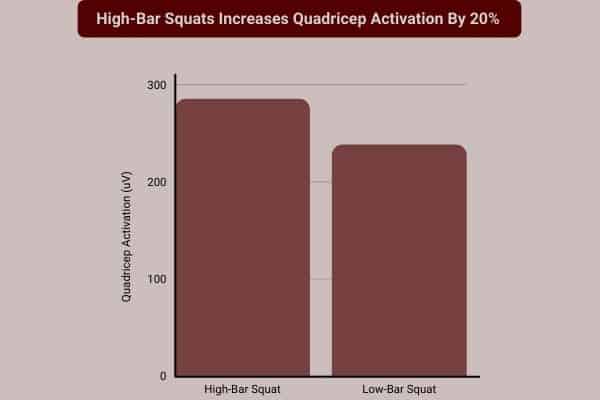Below, are 8 interesting squat statistics for 2023. All numbers and data have been researched through scientific papers and database analysis.
1) Squat World Record Holders
Most would argue that the squat is the King Of Exercises. It’s a powerhouse of a movement with many benefits and requires all the muscles of the lower (and upper) body to fire on all cylinders.
And a post about squat statistics wouldn’t be complete without mention of the Kings and Queens who hold the world records for the exercise, would it?
So here they are for you- the heaviest and the most squats ever performed by human beings:
| Squat Division: | Title Holder: | Record: |
|---|---|---|
| Heaviest (equipped) | Brian Carroll 2020 | 1,306lbs / 592kg |
| Heaviest (raw) | Ray Orlando Williams 2019 | 1,080lbs / 490kg |
| Heaviest (female) | Becca Swanson 2010 | 854lbs / 387kg |
| Heaviest relative to bodyweight (female) | Wei-Ling Chen 2016 | 462lbs / 210kg |
| Most bodyweight squats In 1 hour | Paddy Doyle 2007 | 4,708 squats |
| Most bodyweight squats In 24 hours | Joe Reverdes 2020 | 25,000 squats |
- Brian Carrol completed his 1,306lbs equipped squat with assistance from a multi-ply lifting suit and knee wraps. These are legal in the powerlifting world, helping the lifter to support the gargantuan weights lifted. It took him 4 attempts to hit 1,306 pounds.
- Ray Williams smashed his 1,080lbs unequipped squat (raw) with nothing but his own strength and an incredible dose of pure grit. This is Ray’s second record-breaking squat. He previously squatted 1,005 pounds at the 2016 USAPL Raw Nationals, which was the first 1000+ squat to ever be recorded at the time. 3 years later, in 2019, Ray managed to break his previous record by hitting 1,080 pounds.
- Becca Swanson began her squatting career in the 2002 Strongwomen competitions, and it took her 8 years of training to smash out the 854lbs female record. She’s the first and only female to ever be able to squat over 800 pounds. Becca’s impressive squat number is equivalent to 3.46x her body weight.
- Wei-Ling squatted a colossal 462lbs in 2016 which equates to 4.5x her own body weight. This makes Wei-Ling, who is only 4 foot 10, one of the strongest squatters in the world in terms of relative body weight strength.
- Paddy Doyle completed his impressive 4,708 bodyweight squats in 1 hour at Stamina’s Boxing Self-Defence Gym in Erin Go Bragh Sports Centre, Birmingham, UK. He’s an ex-UK paratrooper and is no stranger to pushing outside his own boundaries.
- Joe Valverdes completed his (literally) breathtaking 25,000 squats in 23 hours and 43 minutes, at the A&D Fitness Centre in Rhode Island, USA. You would rightly assume Joe did plentiful preparation prior to his record-breaking attempt. As part of his training, Joe actually completed an unofficial 16,064 squats in 22 hours in 2018.
If you’re new to squatting, you may be interested in my favorite types of squats for beginners!
2) How Much Men Should Squat Relative To Body Weight
An average male beginner should be able to squat 1x their body weight for a single repetition (1-rep max). With 2 years of training, squat strength is expected to increase to 1.6x body weight. And after 5 years of training, squat strength is expected to increase to 2.0 to 2.5x body weight.
Here’s a graph showing male 1-rep max squat standards according to body weight:

As you can see, the average 1 rep max squat standards for men are as follows:
- Beginners- should be able to squat an average of 0.9x body weight.
- Novices- should be able to squat an average of 1.2x your body weight.
- Intermediates- should be able to squat an average of 1.6x your body weight.
- Advanced- should be able to squat an average of 2.0x your body weight.
- Elites- should be able to squat an average of 2.5x your body weight.
These numbers are for the barbell back squat.
You may also be interested in dumbbell squat standards for the:
3) How Much Women Should Squat Relative To Body Weight
An average female beginner should be able to squat 0.6x their body weight for a single repetition (1-rep max). With 2 years of training, squat strength is expected to increase to 1.1x body weight. And after 5 years of training, squat strength is expected to increase to 1.5 to 1.9x body weight.
Compared to men, women have less muscle mass and strength so are able to squat considerably less weight.
Here’s the graph showing the female 1 rep max squat standards according to body weight:

As you can see, the average 1 rep max squat standards for women are as follows:
- Beginners- should be able to squat an average of 0.5x your body weight.
- Novices- should be able to squat an average of 0.7x your body weight.
- Intermediates- should be able to squat an average of 1.1x your body weight.
- Advanced- should be able to squat an average of 1.5x your body weight.
- Elites- should be able to squat an average of 1.9x your body weight.
These numbers are for the barbell back squat.
4) Percentage Of People Who Can Squat 2x Their Body Weight
20% of males aged 24 to 39 are able to squat twice their body weight for a single repetition. In comparison, only 5% of females aged 24 to 39 are able to squat twice their body weight. The difference of 15% is due to men having more muscle mass and strength compared to females.
Here’s the percentage of males (aged 24-39), at body weights of 110 to 290 pounds, who can squat double their body weight for 1-rep:
| Male Bodyweight (lb): | % Who Can Squat 2x Bodyweight |
|---|---|
| 110 | 12% |
| 140 | 24% |
| 170 | 24% |
| 200 | 22% |
| 230 | 19% |
| 260 | 16% |
| 290 | 13% |
| Average: | 20% |
Next, here’s the percentage of females (aged 24-39), at body weights of 90 to 270 pounds, who can squat double their body weight for 1-rep:
| Female Bodyweight (lb): | % Who Can Squat 2x Bodyweight |
|---|---|
| 90 | 15% |
| 120 | 9% |
| 150 | 5% |
| 180 | 2% |
| 210 | 1% |
| 240 | 0.5% |
| 270 | 0.2% |
| Average: | 5% |
5) Percentage Of People Who Can Squat 3x Their Body Weight
0.9% of males aged 24 to 39 are able to squat twice their body weight for a single repetition. In comparison, only 0.5% of females aged 24 to 39 are able to squat twice their body weight.
Here’s the percentage of males (aged 24-39), at body weights of 110 to 290 pounds, who can squat triple their body weight for 1 rep:
| Male Bodyweight (lb): | % Who Can Squat 3x Bodyweight |
|---|---|
| 110 | 2% |
| 140 | 2% |
| 170 | 1% |
| 200 | 0.7% |
| 230 | 0.4% |
| 260 | 0.2% |
| 290 | 0.1% |
| Average: | 0.9% |
Now here’s the percentage of females (aged 24-39), at body weights of 90 to 210 pounds, who can squat triple their body weight for 1 rep:
| Female Bodyweight (lb): | % Who Can Squat 3x Bodyweight |
|---|---|
| 90 | 2% |
| 120 | 0.4% |
| 150 | 0.1% |
| 180 | 0.02% |
| 210 | 0.003% |
| 240 | N/A |
| 270 | N/A |
| Average: | 0.5% |
6) How Much The Average American Should Be Able To Squat
The average American male beginner-intermediate weighing 200lbs should be able to squat around 250 pounds for a single repetition. The average American female beginner-intermediate weighing 170lbs should be able to squat around 130 pounds.
Here are the 1 rep max squat figures for a 200lbs American male beginner and intermediate:
| Beginner Squat 1 RM (lb) | Intermediate Squat 1 RM (lb) | Average Squat 1 RM (lb) |
|---|---|---|
| 184lbs | 321lbs | 252lbs |
Based on these figures, the average 200lb American male should be able to squat around 250 pounds for one repetition. That’s 19% of the heaviest male squat made by Brian Carroll in 2020!
Now, here are the 1 rep max squat figures for a 170lbs American female beginner and intermediate:
| Beginner 1 RM (lb) | Intermediate 1 RM (lb) | Average 1 RM (lb) |
|---|---|---|
| 84lbs | 183lbs | 134lbs |
Based on these figures, the average 170lb American female should be able to squat around 130 pounds for one repetition. That’s 15% of the heaviest female squat made by Becca Swanson in 2020!
You may also be interested in my other post on deadlift statistics!
7) High- Vs Low-Bar Squat Muscle Activation
High- and low-bar squats both activate the quadriceps. But the high-bar variation activates the quadriceps 20% more than the low-bar variation. High-bar squats are therefore better suited to emphasizing the quads compared to low-bar squats.

This was demonstrated in a 2020 study.
Here, 10 powerlifters performed the low-bar squat (barbell sat low on the upper back) and the high-bar squat (barbell sat high on the upper back).
Electrodes were also attached to each subject’s quadriceps, allowing for muscle activity to be measured.
Here’s what they found:
| Quadriceps Muscle: | High-Bar Squat Muscle Activation (uV) | Low-Bar Squat Muscle Activation (uV) |
|---|---|---|
| Rectus Femoris | 225 | 183 |
| Vastus Medialis | 345 | 292 |
| Average: | 285 | 238 |
As you can see, the high-bar squat activates the quadriceps by an average of 285 uV. In comparison, the low-bar squat activated the quadriceps by only 238 uV (20% lower).
The difference in quad activation is explained by the barbell position.
The barbell sits lower in the low-bar squat, causing your back to angle forwards (similar to a deadlift). And this results in tension being shifted away from the quads and onto the hamstrings.
8) Squat Muscle Activation Using A Full Vs Half Range Of Motion
Squatting with a full range of motion leads to increased muscle activation compared to using a half range of motion. Furthermore, increased muscle activation leads to greater squat strength and leg muscle size development from a training program.
This was demonstrated in a 2019 study that showed the difference between squatting with a full range of motion (a full squat) a half range of motion (half squat).
17 participants were assigned a 10-week training program squatting 2 days per week. One group trained with full squats, whilst the other trained with half squats.
At the end of the 10 weeks, the participant’s squat 1 RM and leg muscle volumes were then measured.
Here are the results:
| Leg Improvement: | % Increase With Full Squat Training | % Increase With Half Squat Training |
|---|---|---|
| Squat 1 Rep Max | 31.8% | 11.3% |
| Quadricep Volume | 4.9% | 4.6% |
| Hamstring Volume | – | – |
| Hip Adductor Volume | 6.2% | 2.7% |
| Gluteus Maximus Volume | 6.7% | 2.2% |
You can see that full squat training increased squat 1 RM by 31.8%. In comparison, half squat training only increased squat 1 RM by 11.3%.
Therefore squat training with a full range of motion can increase your 1 RM by around 20.5%.
Additionally, a full range of squatting motion increased hip adductor volume by 6.2% and gluteus maximus volume by 6.7%. In comparison, a half range of squatting motion only increased the hip adductor by 2.7% and gluteus maximus by 2.2%.
So if you want to gain the full benefits from your squats, you should apply a full range of motion!
You may also be interested in my other post to find out why you should not train your legs every day.
Conclusion
That’s 10 of my favorite squat statistics and scientific findings for 2023.
They can help you to benchmark your own squat progress and the scientific findings can be applied to your own squat training.
You may also be interested in the downloadable Kalibre Blueprint PDF which details exactly how I gained 40lbs of lean muscle (it’s 100% free!). It details the exact exercises and nutrition (with printables) I used to go from skinny to ripped!


